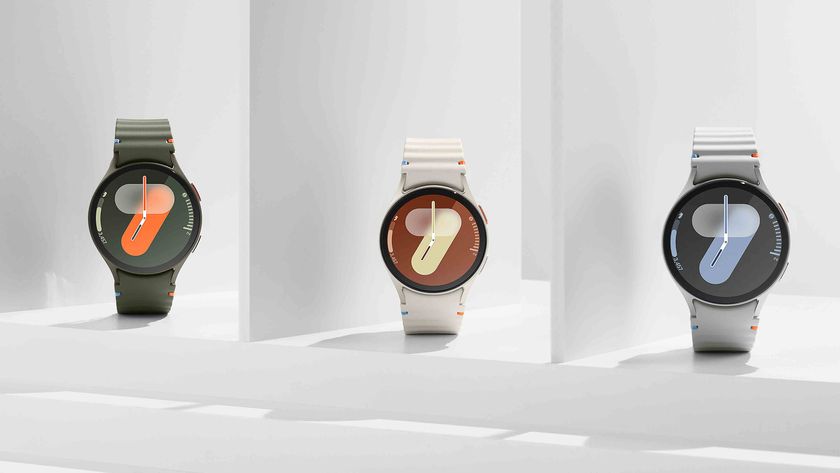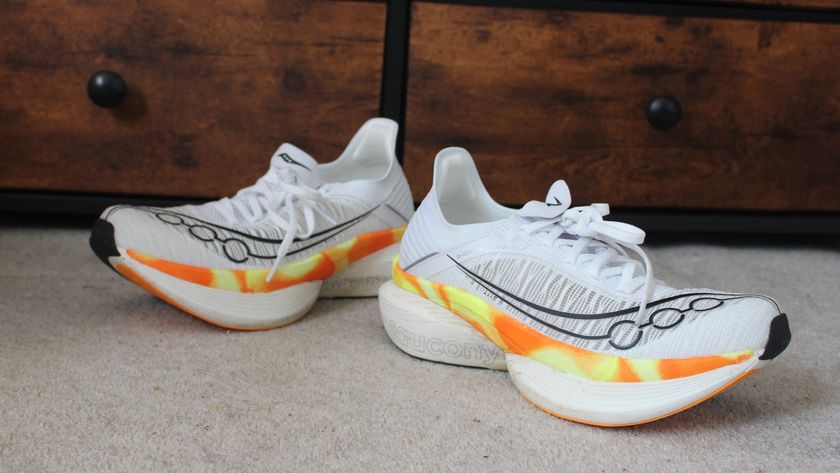Zwift Run: a cure for the dreaded ills of the treadmills
Finally I don't mind being forced to run indoors

Dear god, I hate treadmills. The thud, thud, thud of my feet over the dull whining of the machine dragging time down to one-hundredth of its usual speed.
But I’m currently injured with an inflamed Achilles, and while I’m allowed to run, it’s only light stuff… so the treadmill is where I need to go. So new tech from Zwift, something that can transport me to a virtual world while I pound the rubber, is more than intriguing.
You might have heard about Zwift for cycling - if not, it allows riders to use their bike on a static turbo trainer in their living room to pedal against real people in digital worlds.
It’s become incredibly popular as a way to stay trained up without having to head out into the elements, and it is incredibly impressive, even for a novice cyclist like me.
Now that system is being offered as a running app, currently in a beta (and free) mode as Zwift gets it ready for the mainstream.
So given some top athletes really advocate running on a treadmill as a successful way to train - and I’m still hoping to attack the London Marathon next month - I decided to give this a bash.
The set up
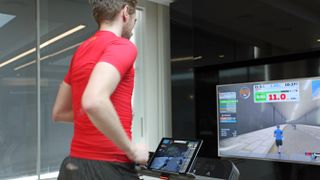
If you’ve not signed in with Zwift before, you’ll need to set up your account and create an avatar. Make it a good one, as you’ll be staring at, well, its pixel-filled butt for a good while on your run.
Get daily insight, inspiration and deals in your inbox
Sign up for breaking news, reviews, opinion, top tech deals, and more.
You’re also encouraged to put your current 5K, 10K, half marathon or other times in here, to educate the system on your pace and offer tailored workouts to match your ability.
There are two different ways to use Zwift Run- you can either connect a treadmill to an Apple TV (we used the TechnoGym MyRun, which is a really nifty, pared-back running machine that can connect via Bluetooth to the Apple unit) or sync a sensor on your shoe with an iPad or phone.
If you go for the latter, you’ll need a treadmill with a ledge for your iPad to sit on, and calibrate the sensor on your shoe by running at a steady speed for 60 seconds.
Once you’ve chosen your method of running, there are a load of options to get you running. You can choose a target distance, time or calorie burn… the latter is nicest as it gives me a timely reminder that some running will not only get me fitter, but permits me to indulge in some tasty treats after.
Let’s go
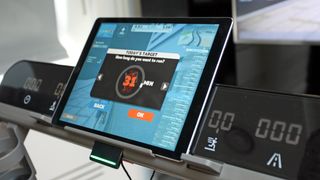
I started off using the larger Apple TV screen, something large and in my eyeline to stop my gaze from wandering while running.
I was suspicious from the start - because running on a treadmill and cycling on a turbo trainer are very different things. Where the latter is active, meaning any effort you crank in is instantly shown on the screen, the former you’ll need to manually boost the speed of the treadmill.
That’s a disconnect from the virtual world - if you’re cycling and suddenly get an adrenaline boost, you can just go for it… with running it’s a little more delayed, and ruins the buzz a bit.
But I instantly enjoyed running with Zwift more than staring at a hotel gym wall. Jogging in the virtual worlds - of which there are a few to choose from, including Watopia and its volcanoes or the city of London - gives you a visual aspect of being able to see a road in front of you, taking your mind away from the monotony of the effort.
In these digital playgrounds there are too many cyclists at this point and not enough runners. Zwift tells me this is because it doesn’t want a lonely running experience - as the service is in beta, there aren’t a lot of runners populating it, so it’s making sure the experience is more vibrant by filling it with bikes.
After a few minutes of just jogging and getting acclimatised, I decided it’s time for a workout - this exercise mode is one of the best parts of Zwift cycling, creating different speed intervals to attack.
While there aren’t as many workouts for the runner, the fact they’re based on your own pace means you’ll always be pushing at just the right amount.
I’ll tell you what… it’s weird to watch yourself run, even if it is a digital avatar. The workouts are excellent in terms of taking the effort of deciding how hard to go away from me, but I wish I didn’t have to keep an eye out for increases in speed… if only the treadmill could do it for me, but apparently that’s not possible just yet.
That said, I enjoyed the run far more than on any other treadmill workout I’ve done. There’s so much more to look at, whether it’s my speed, other runners who might be around or just watching as a coloured gate comes into view, telling me the next stage of the workout is on its way.
I hit the stop button and strapped a Stryd Live footpod to my shoe to try the same thing with the iPad. I expect this is the method most people will use, as it’s unlikely you’ll have the right treadmill and Apple TV around, and the distances and speed it was showing was incredibly accurate compared to what the treadmill readout was saying.
My main takeaway was that it still sucked having to manually choose my own speeds, but if you’re used to running on treadmills it won’t feel that alien. It’s just nowhere near the same as running outside.
Socially awkward
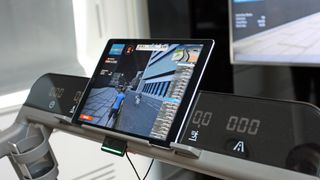
While the improvement in your motivation to workout on a treadmill is good, and the founding reason that Zwift cycling took off in the first place, there’s a bigger challenge Zwift needs to solve with its running platform.
It’s the social element - whether that’s joining a run at a pre-arranged time with pals across the world, one of the runs organised by pace from Zwift (with four pace levels at distances ranging from 5K to half marathon) or just seeing others around you when jogging alone in a basement.
And right now, the social side is very much in its infancy (hence the app being in beta). It’s fun being able to chuck out a verbal high five or give someone some banter about how you’re going to beat them, but I didn’t actually see anyone I could do that with in my test.
We tried to just join someone already running, but by the time I’d entered the world and got the treadmill up to speed, the guy we wanted to run with had disappeared into the distance. It ended up with me sprinting after a virtual stranger… and he seem to just vanish into the ether. That felt a bit, erm, weird.
Perhaps trying one of the group runs would be better - but unless you have a treadmill at home, that’s going to be hard to sync up right now, as there aren’t loads on offer. With cycling, the social side simply grew out of the app’s popularity, and Zwift has to do all it can to make this a ‘must-use’ platform for runners and see the social element grow from that.
The barriers
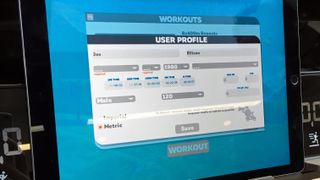
While I enjoyed my workout through the virtual streets of London, there are still some limitations that stop me from feeling like I’d rather pull out my iPad and get on a treadmill over spending some time outside.
The key thing is that disconnect between my legs and the screen. For cycling, some turbo trainers can alter the resistance depending on virtual hills, making it easier or harder to ride, but treadmills can’t do the same.
It would be amazing if the machine could physically raise or lower depending on the hills on screen, or speed up and slow down depending on what the workout required of you.
Zwift says this isn’t possible due to health and safety, as sending the treadmill spinning up too fast suddenly could cause people to stumble and fall off.
And then there’s that issue that plagues all social runners: wanting to run with people of a different fitness level.
One of the great things about the organised rides on Zwift is that they’ll automatically match effort. With a turbo trainer, many can work out your Functional Threshold Power (FTP), a levelling metric that shows how hard you’re working and not how fast you’re going, and keeps all the riders together as long as they’re all working as hard as each other.
There’s no way to easily do the same for runners… so it’s just a case of hoping you’re with the right pace group and running as hard as you need to.
Again, Zwift says this is something that’s been looked at but it’s not incorporated the power meter that some footpods can bring to running for some reason. This is all the more odd given Zwift is already working with Stryd who make just such a device, but that will possibly happen in the future.
To the future

Speaking about what’s happening next, there’s a lot more to come from this system, as you’d expect given it’s still in a developments stage.
More treadmills need to be supported to work with Apple TV, and thankfully that's happening. There are a plethora of Bluetooth-enabled running machines on the way, and Zwift is working hard to make them app-compatible so you can get more out of your indoor jogging.
One of the things that would get me on this system multiple times a week is races - instead of group runs where you stay together, the goal being to run faster than all of those around you. Making myself want to be sick on a treadmill would be much easier if I was trying to beat a random man from Japan at half past four on an idle Wednesday.
Zwift says this is something that is being considered at the moment, and I’m crossing all my fingers this happens.
But if I'm really getting into a fantasy wishlist here, the real magical thing would be if I could wear a pair of augmented reality glasses at the same time as running on a treadmill.
Being able to turn my head as I ran and see the virtual world move with my gaze, feel the wind from a fan dynamically altering the breeze… that would be so close to the real thing that it would really encourage many people who just don’t want to go outside to get running.
That’s a long way off and there’s no way this would ever work with a clunky VR headset on your head… but perhaps if Apple’s AR glasses take off, this could be a real possibility.
But the main thing Zwift Run needs is momentum - more people need to be using this platform, to hear about it, to want to actively seek out a treadmill and fire up their iPad and enter the virtual world, and only making this system as seamless as possible is going to achieve that.
Here’s the key thing for me though: straight after my workout, I now feel a lot more excited about running on a treadmill, the mix of tech and a distraction just what I’m looking for when I’m forced to run indoors.
If you’re injured, or prefer not to exercise outside for personal reasons, Zwift Run is a magical way to enjoy running in a new way.
Seeing your metrics displayed on the screen, instantly uploaded to Strava and full of interaction with other people, is a lovely thing that shows the unifying power of technology.
Zwift Run can’t hold a candle to the beauty of running outdoors, and the very fact you need Wi-Fi to make it work properly (or a 4G connection) is also going to be limiting to some.
But my main takeaway was a positive one - this new platform may not be the future of running, with us all jogging about in a digital utopia, but it’s a massive step forward in taking away one of the more dreary aspects of training.
- Gareth Beavis is TechRadar's Running Man of Tech, testing the latest in fitness technology in a never-ending quest to run further and faster and bringing you the results in this column.
- If you want to say hi, he's @superbeav on Twitter
- You can see his stumblings on Strava
- And for more data, follow him on Smashrun
- And if you want to get the full lowdown on the latest and greatest running tech, read the rest of the Running Man of Tech story here

Gareth has been part of the consumer technology world in a career spanning three decades. He started life as a staff writer on the fledgling TechRadar, and has grew with the site (primarily as phones, tablets and wearables editor) until becoming Global Editor in Chief in 2018. Gareth has written over 4,000 articles for TechRadar, has contributed expert insight to a number of other publications, chaired panels on zeitgeist technologies, presented at the Gadget Show Live as well as representing the brand on TV and radio for multiple channels including Sky, BBC, ITV and Al-Jazeera. Passionate about fitness, he can bore anyone rigid about stress management, sleep tracking, heart rate variance as well as bemoaning something about the latest iPhone, Galaxy or OLED TV.
